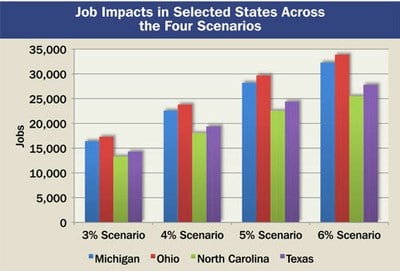7,5K
Le CERES, qui rassemble une coalition nationale aux USA – entrepreneurs, ONG, autorités publiques – autour du développement durable, vient de publier un rapport quantifiant les bénéfices économiques et sociaux apportés par la mise en oeuvre d'une réglementation sur l'efficacité énergétique des véhicules légers.
L'administration OBAMA propose un objectif moyen de 54.5 miles per gallon pour 2025, soit 4.3 litre/100 km ou 101 gCO2/km. L'étude a quantifié les emplois engendrés par le besoin de recherche nécessaire pour atteindre cet objectif.
- The six percent scenario (roughly 60 MPG) would generate an estimated $152 billion in fuel savings for consumers in 2030 compared to business as usual. Of the $152 billion saved at the pump, $59 billion would be expected to be spent in the auto industry as drivers purchase cleaner, more efficient vehicles. The remaining $93 billion will be spent across the rest of the economy, boosting consumers’ discretionary income for everything from retail purchases to restaurant trips to increased spending on health care.
- Nearly 700,000 new full time jobs would be created under the six percent scenario, compared to only about 350,000 jobs under the three percent (roughly 47 MPG) scenario.
- 63,000 new, full-time domestic auto industry jobs would be created in 2030 under the six percent scenario; more than double the 31,000 jobs under the three percent scenario.
- States seeing the biggest gains in terms of relative impact on their job markets also have some of the largest auto industry sectors. Again, job growth would be significantly higher under the six percent scenario. The top 12 states in terms of percentage job increases include Indiana, Michigan, Alabama, Kentucky, Tennessee, Ohio, North Carolina, New Hampshire, Vermont, Oregon, New York and Missouri.
- Net jobs gains in 49 states, and greatest job gains under strongest standards. Each of the four regulatory scenarios analyzed would bring substantial economic and job benefits for the U.S. economy in 2030.
- Effects on state GDPs would be overwhelmingly positive. States seeing the biggest percentage GDP gains under the strongest fuel efficiency standard have large auto industry sectors. The biggest gainers would be Michigan and Indiana, followed by Kentucky, South Carolina, Tennessee, Wisconsin, Iowa, Ohio, Alabama and Oregon. Compared to the three percent scenario, the six percent scenario would bring 382,000 more jobs, a $15.7 billion increase in gross economic output (sales), $10.3 billion more in personal income, and $9.5 billon more in tax revenue for cash strapped federal, state and local governments.
Ceres cafe jobs-072811
View more documents from transportsdufutur.
